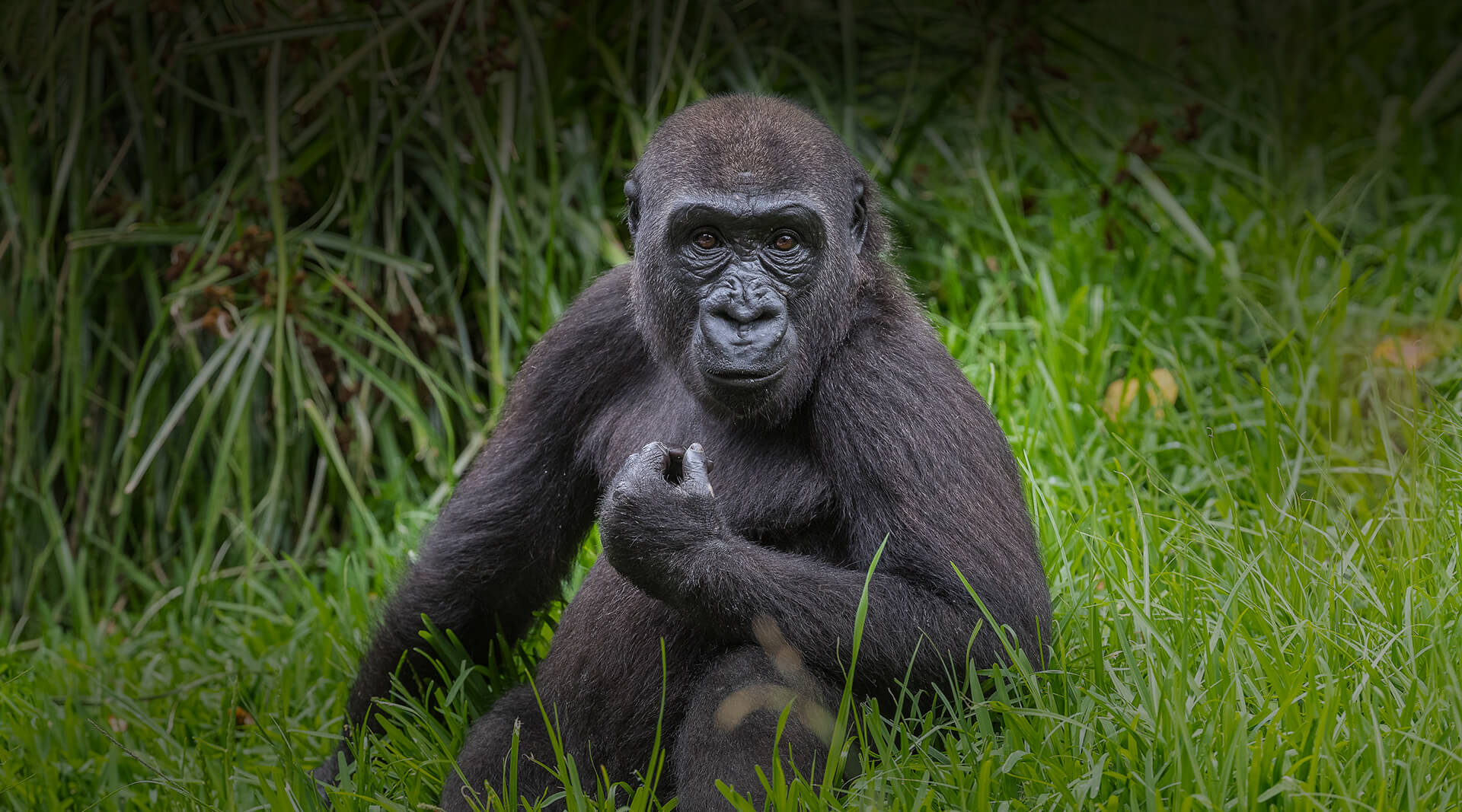Western Gorilla: Peace in the Forest
IUCN Conservation Status: Critically Endangered
Large, muscular, and serious-looking, many people think of gorillas as wildlife to fear—especially the formidable silverback that leads each troop. Despite their reputation, gorillas are peaceful creatures. They are social, expressive, thoughtful, and intelligent. Gorillas spend their days foraging for vegetation and their nights tucked into leafy nests. They depend upon the forest, and the forest depends upon them, too.
Gorillas have no natural enemies or predators, yet these great apes are at critical risk because of humans. The rampant destruction of fragile forest habitat is one of the greatest threats to gorilla survival. Logging and mining companies destroy gorilla habitat across their range in Central Africa to meet demand for paper products and materials for our electronic devices. These activities also bring humans and gorillas into closer proximity, heightening the risk of disease transmission.
Illegal bushmeat hunting continues to be a lucrative commercial activity in the region, and while gorillas may not always be direct targets, some individuals die or lose limbs after being accidentally trapped in snares targeting other mammals. The illegal pet trade also poses a threat; poachers kill several troop members to catch a single infant gorilla. Once in the pet trade, gorillas face a lonely life without proper care. Wildlife trafficking, including the pet and bushmeat trades, is also responsible for disease epidemics such as the Ebola virus that has recently decimated some gorilla populations.
Collaborative Conservation
Our work to protect gorillas is done in tandem with local communities in Central Africa. “Everything about the health of the forest is reflected in the health of the communities,” says Bethan Morgan, Ph.D., head of San Diego Zoo Wildlife Alliance’s African Forest Program.
We concentrate our gorilla conservation efforts through the African Forest Program based in Cameroon’s Ebo Forest, one of the largest and most ecologically intact rainforests remaining in the Gulf of Guinea Biodiversity Hotspot (encompassing around half of the Yabassi Kew Biodiversity Area), and home to more than 50 globally threatened plant and animal species on the IUCN Red List of Threatened Species. “The cultural significance of this forest is critical,” says Ekwoge Abwe, Ph.D., postdoctoral fellow at San Diego Zoo Wildlife Alliance and manager of the Ebo Forest Research Project. Our efforts in Cameroon wouldn’t be possible without long-standing collaborative relationships with our partners, including local communities as well as multiple governmental ministries, national and international academic institutions, and traditional authorities.
Saving gorillas also requires inspiring and empowering the next generation of conservationists. We host national and international researchers and university students and help train Cameroon’s future wildlife law enforcement officials.
We are supporting the fledgling Association of Ebo Traditional Chiefs to lead conservation initiatives and sustainable development into the future. In 2020, conservationists and researchers were successful in coming together to ask Cameroon’s Prime Minister to set aside plans for logging concessions in the Ebo Forest. The government is now working with a range of stakeholders including local communities to develop a sustainable land-use plan across the entire forest and surrounding communities. Adopting a more inclusive process is an indication that the government intends to honor its commitments to reduce greenhouse gas emissions.
In the Field
Our collaborative approach is perhaps best reflected in our Clubs des Amis des Gorilles (Gorilla Guardian Clubs) in the Ebo Forest. The grassroots community initiative brings together local people, including community elders and traditional authorities, to support active, on-the-ground conservation, as well as enhance the local communities’ collective responsibility for and pride in the incredible biodiversity of the Ebo Forest. With our support, local communities are reaping real dividends in terms of improving lives and saving wildlife.
The Gorilla Guardian Clubs initiative started with a handful of young, dedicated ex-hunters who realized, through working with us, that unless hunting pressure is reduced, many of the magnificent forest species would never be seen by their children. Some club members work with our trained field assistants to monitor the gorilla habitat and record signs of gorillas and threats to them over time. Clubs also organize community engagement activities such as storytelling, discussions, and film shows, and involve local schoolchildren to spread and embed the positive benefits of looking after the forest and wildlife. We also support these clubs’ efforts in small-scale sustainable livelihood projects such as cocoa farming, beekeeping, poultry farming, soap making, and the processing of cassava tubers.
Back in San Diego, our team is using innovative techniques to gather complete genetic information from gorillas in the North American zoo population. With this information, we can address questions about the level of genetic diversity in zoos, the number of genetic lineages, and the presence of genetic structure. This type of information may be applied in the field in Africa to help identify the geographic origin of poached animals and pinpoint areas of intense wildlife trafficking.
Sharing knowledge and innovation is critical to making an impact on conservation challenges around the world. For example, when the gorilla troop at the San Diego Zoo Safari Park was diagnosed with SARS-CoV-2—the virus that causes COVID-19 in humans—in late 2020, we immediately recognized how sharing information about their case may help to protect apes in their natural habitat. San Diego Zoo Wildlife Alliance joined forces with many local, state, and national leaders in the medical, scientific, zoological and public health communities. In addition to providing the best care possible for the gorilla troop, this ongoing teamwork could contribute to a deeper understanding of the impacts of this virus on animals and people worldwide. San Diego Zoo Wildlife Alliance continues to share what we have learned about curbing zoonotic disease transmission, biosecurity protocols in managed care and field settings, and the implications to ensuring optimal health outcomes for humans and wildlife globally.

